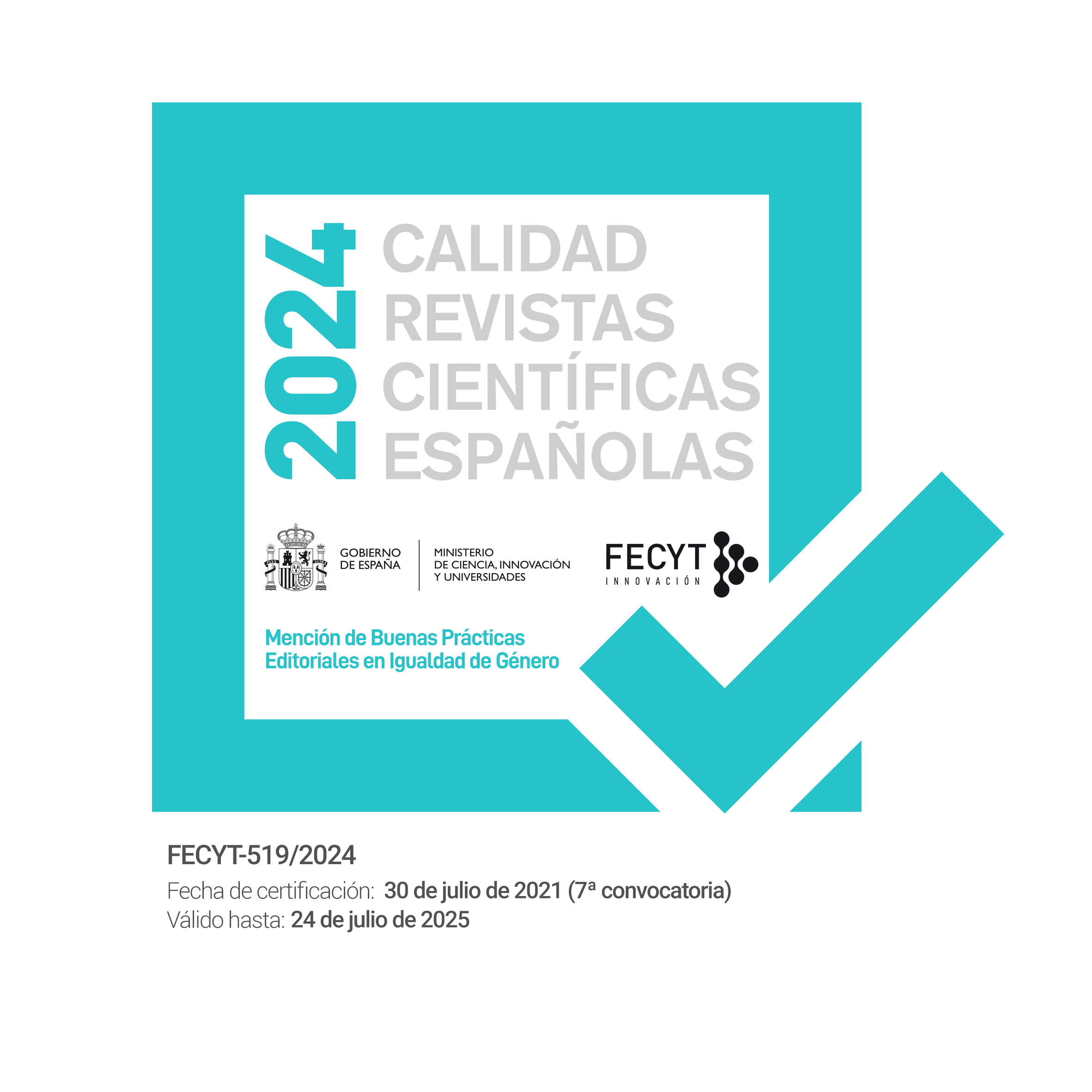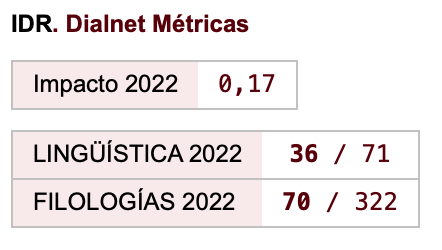Non-pronominal uses of it: a case study in women’s fashion magazines
Keywords:
Anglicisms, pseudo-Anglicisms, non-pronominal it, conversion, fashion lan-guageAbstract
The use of English as a global language has largely affected other languages, both in general and specialized areas, particularly at the lexical level due to themassive borrowing of English words. Anglicisms are most visible in the language of fashion, where they are highly appreciated and associated to prestige and “coolness”, apart from linguistically representing the rapid advances and modernization of fashion that sometimes make languages unable to cope with the speed with which extralinguistic realities change. The present study, based on a sample of over four million words from leading fashion magazines published in Spanish, focuses on the use of itin its non-pronominal uses, that is, it aims at identifying and describing the adjectival uses of itwhich may be either directly taken from English in short phrases or compounds like it girl, or adapted to Spanish linguistic contexts as in “calzadoit”,“más it”,“lait prenda”. Furthermore, the study also reveals new uses of it, or rather pseudo-English uses that appear in Spanish fashion magazines and which are the result of different linguistic phenomena. In particular, nominal uses like “la ‘it’ del mes”, “todas las it”or “nuestrasits favoritas” have been detected.Downloads
References
Ai, H. & You, X. (2015). The grammatical features of English in an Internet discussion forum. World Englishes, 34(2), 211-230.
Alcaraz Ariza, M.A. (2000). Anglicismos en el lenguaje de las ciencias de la salud. Alicante: Universidad de Alicante.
Alfaro, R. (1970). Diccionario de anglicismos. Madrid: Gredos.
Anderman, G. & Rogers, M. (Eds.) (2005). In and Out of English: For Better, For Worse? Clevedon: Multilingual Matters.
Andersen, G. (2014). Pragmatic borrowing. Journal of Pragmatics, 67(1), 17-33.
Balteiro, I. (2007). A Contribution to the Study of Conversion in English. Münster/New York/München/Berlin: Waxmann Verlag.
Balteiro, I. (2011a). A few notes in the vocabulary of textiles and fashion. In I. Balteiro (Ed.), New Approaches to Specialized English Lexicology and Lexicography (pp. 83-96). Newcastle: CSP.
Balteiro, I. (2011b). A reassessment of traditional lexicographical tools in the light of new corpora: Sports Anglicisms in Spanish. International Journal of English Studies, 11(2), 23-52.
Balteiro, I. (2014). The influence of English on Spanish fashion terminology: -ing forms. ESP Today, 2(2), 156-173.
Balteiro, I. 2016. A look at metalinguistic jokes based on intentional morphological reanalysis. In L. Ruiz-Gurillo (Ed.), Metapragmatics of humor: Current Research Trends (pp. 127-143). Amsterdam: John Benjamins.
Balteiro, I. (forthcoming). Emerging hybrid Spanish-English blend structures in Spanish: ‘Summergete con socketines’. Lingua.
Balteiro, I. & Campos, M.A. (2012). False Anglicisms in the Spanish language of fashion and beauty. Ibérica, 24, 233-260.
Barthes, R. (1983). The Fashion System. New York: Hill & Wang.
Bhatia, V.K. (2004). Words of written discourse: A genre-based view. London: Continuum.
Bolaños Medina, A. & Luján García, C. (2010). Análisis de los anglicismos informáticos crudos del léxico disponible de los estudiantes universitarios de traducción. Lexis, 34(2), 241-274.
Cabré, M.T. (1999). Terminology. Theory, Methods and Applications. Amsterdam: John Benjamins.
Campos, M.A. (2011). False Anglicisms in Legal and Business English as a Lingua Franca (ELF): A Process of Back-Borrowing. In I. Balteiro (Ed.), New Approaches to Specialized English Lexicology and Lexicography (pp. 83-96). Newcastle: CSP.
Campos-Pardillos, M.A. (2015). All is not English that Glitters: False Anglicisms in the Spanish Language of Sports. Atlantis, 37(2), 155-174.
Crespo Fernández, E. & Luján García, C. (2017). Anglicisms and Word Axiology in Homosexual Language. Revista Española de Lingüística Aplicada RESLA, 30(1), 74-102.
Crystal, D. (2012). English as a global language. Cambridge: Cambridge University Press.
Damhorst, M.L., Miller-Spillman, K.A. & Michelman, S.O. (1999). The Meanings of Dress. New York: Fairchild.
De Houwer, A. & Wilton, A. (Eds) (2011). English in Europe Today. Amsterdam/Philadelphia: John Benjamins.
Díez-Arroyo, M. (2015). ‘From the atelier to e-commerce: a cognitive approach to neologisms in Spanish fashion.’ Terminology, 21(1), 51-75.
Díez-Arroyo, M. (2016a). English words as euphemisms in Spanish Fashion. English Today, 32(3), 30-39.
Díez-Arroyo, M. (2016b). Vagueness: A Loanword’s Good Friend. The Case of ‘Print’ in Spanish Fashion. Pragmatics, 26(4), 609-629.
Fischer, R. & Pulaczewska, H. (Eds.) (2008) Anglicisms in Europe: Linguistic Diversity in a Global Context. Newcastle-upon-Tyne: Cambridge Scholars Publishing.
Flügel, J.C. (1930). The Psychology of Clothes. London: Hogarth Press.
Furiassi, C. (2010). False Anglicisms in Italian. Monza: Polimetrica.
Furiassi, C., Pulcini, V., & Rodríguez González, F. (Eds.) (2012). The Anglicization of European Lexis. Amsterdam/Philadelphia: John Benjamins Publishing Company.
García Morales, G. (2009). Análisis de los anglicismos léxicos del lenguaje cinematográfico registrados en muestras escritas entre 2002 y 2006. Tesis Doctoral. Las Palmas de Gran Canaria: Universidad de las Palmas de Gran Canaria.
García Morales, G., González Cruz, M.I., Luján García, C. & Rodríguez Medina, M.J. (2016). La presencia del inglés en la publicidad televisiva española (2013-2015). Madrid: Síntesis.
Gómez Capuz, J. (2001). La interferencia pragmática del inglés sobre el español en doblajes, telecomedias y lenguaje coloquial: una aportación al estudio del cambio lingüístico en curso. Revista electrónica de estudios filológicos, 2. <https://www.um.es/tonosdigital/znum2/estudios/Doblaje1.htm> [22/10/2017]
González Cruz, M.I. & Rodríguez Medina, M.J. (2016). On the Pragmatic Function of Anglicisms: A Case Study, Revista Alicantina de Estudios Ingleses, 24, 257-273.
Görlach, M. (2001). A Dictionary of European Anglicisms. Oxford: Oxford University Press.
Görlach, M. (Ed.) (2002a). English in Europe. Oxford: Oxford University Press.
Görlach, M. (Ed.) (2002b). An Annotated Bibliography of European Anglicisms. Oxford: Oxford University Press.
Görlach, M. (2003). English Words Abroad. Amsterdam/Philadelphia: John Benjamins.
Gottlieb, H. & Furiassi, C. (2015). Getting the grips with false loans and pseudo-Anglicisms. In C. Furiassi & H. Gottlieb (Eds.), Pseudo-English: Studies on False Anglicisms in Europe (pp. 3-33). Boston/Berlin: De Gruyter Mouton.
Haarmann, H. (1986). Verbal strategies in Japanese fashion magazines —a study in impersonal bilingualism and ethnosymbolism. International Journal of the Sociology of Language, 58, 107-121.
López-Zurita, P. (2005). Economic anglicisms: adaptation to the Spanish linguistic system. Ibérica, 10, 91-114.
Lopriore, L. & Furiassi, C. 2015. The influence of English and French on the Italian language of fashion: focus on false Anglicisms and false Gallicisms. In C. Furiassi & H. Gottlieb (Eds.), Pseudo-English. Studies on False Anglicisms in Europe (pp. 197-226). Berlin: Walter de Gruyter.
Lorenzo, E. (1996). Anglicismos hispánicos. Madrid: Gredos.
Luján-García, C. (2010). La presencia de la lengua inglesa en carteles publicitarios en las calles de Las Palmas de Gran Canaria. Miscelánea, 41, 13-36.
O’Hara, G. (1986). The Encyclopedia of Fashion. London: Thames.
Onysko, A. & Winter-Froemel, E. (2011). Necessary loans – luxury loans? Exploring the pragmatic dimension of borrowing. Journal of Pragmatics, 43(6), 1550-1567.
Oxford English Dictionary. (2017). Oxford: Oxford University Press.
Pennycook, A. (1994). The cultural politics of English as an international language. New York: Longman.
Phillipson, R. (2003). English-only Europe? Challenging language policy. London: Routledge.
Pratt, C. (1980). El anglicismo en el español peninsular contemporáneo. Madrid: Gredos.
Price, G. (2014). English for all? Neoliberalism, globalization, and language policy in Taiwan. Language in Society, 43(5), 567-589.
Rodríguez González, F. (1994). Anglicismos en el argot de la droga. Atlantis, 16(1-2), 179-216.
Rodríguez González, F. (1999). Anglicisms in Contemporary Spanish. An Overview. Atlantis, 21(1-2), 103-139.
Rodríguez González, F. (2012). Anglicismos en el mundo del deporte: variación lingüística y sociolingüística. Boletín de la Real Academia Española, 92(306), 317-341.
Rodríguez González, F. (2016). Prólogo. In G. García Morales, M.I. González Cruz, C. Luján García & M.J. Rodríguez Medina, La presencia del inglés en la publicidad televisiva española (2013-2015) (pp. 7-14). Madrid: Síntesis.
Rodríguez González, F. (2013). Pseudoanglicismos en español actual. Revisión crítica y tratamiento lexicográfico. Revista Española de Lingüística (RSEL), 43(1), 123-170.
Rodríguez Medina, M.J. (2016). The use of anglicisms in Spanish television commercials of cosmetics, hygiene and personal care products. Hermes. Journal of Language and Communication in Business, 55, 157-169.
Rodríguez Segura, D. (1999). Panorama del anglicismo en español. Presencia y uso en los medios. Almería: Servicio de publicaciones de la Universidad de Almería.
Sánchez, S. & Durán, R. (2002). Una aproximación pragmática al uso de anglicismos en el derecho español. ELIA, 3, 249-258.
Urrutia Cárdenas, H. (2001). La lengua en los medios de comunicación. Onomazein, 6, 11-30.
Downloads
Published
How to Cite
Issue
Section
License
Authors who publish with this journal agree to the following terms:
- Authors retain copyright and grant the journal right of first publication with the work simultaneously licensed under a Creative Commons Attribution License that allows others to share the work with an acknowledgement of the work's authorship and initial publication in this journal.
- Authors are able to enter into separate, additional contractual arrangements for the non-exclusive distribution of the journal's published version of the work (e.g., post it to an institutional repository or publish it in a book), with an acknowledgement of its initial publication in this journal.
- Authors are permitted and encouraged to post their work online (e.g., in institutional repositories or on their website) prior to and during the submission process, as it can lead to productive exchanges, as well as earlier and greater citation of published work (See The Effect of Open Access).

Revista de Lenguas para fines específicos is licensed under a Creative Commons Reconocimiento-NoComercial-SinObraDerivada 4.0 Internacional License.























